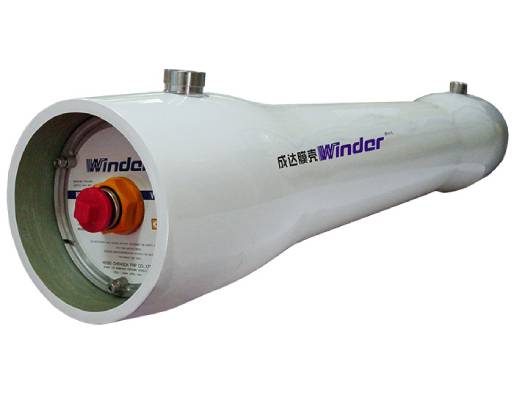At a certain temperature, use a semi-permeable membrane that is permeable to water and impervious to salt to separate the fresh water from salt water. The fresh water moves through the semi-permeable membrane to the direction of the saline. The pressure prevents the left ventricular fresh water from moving to the saline side, and finally reaches equilibrium. The equilibrium pressure at this time is called the osmotic pressure of the solution, and this phenomenon is called the osmotic phenomenon. If an external pressure exceeding the osmotic pressure is applied to the saline side of the right ventricle, the water in the saline solution of the right ventricle moves through the semi-permeable membrane to the fresh water in the left ventricle to separate the fresh water from the saline. Penetration phenomenon.
It can be seen that the basis of reverse osmosis desalination is ① the selective permeability of the semi-permeable membrane, that is, to selectively allow water to pass through without allowing salt to pass through; ② the applied pressure of the brine chamber is greater than the osmotic pressure of the brine chamber and the fresh water chamber , Provides a driving force for water to move from the salt water chamber to the fresh water chamber. The typical osmotic pressure of some solutions is shown in the table below.
The semi-permeable membrane used to separate fresh water from saline is called reverse osmosis membrane. Reverse osmosis membranes are mostly made of polymer materials. At present, the reverse osmosis membranes used in thermal power plants are mostly made of aromatic polyamide composite materials.
RO (Reverse Osmosis) reverse osmosis technology is a membrane separation and filtration technology using pressure difference as its power. Its pore size is as small as nanometers (1 nanometer = 10-9 meters). Under a certain pressure, H2O molecules can pass through the RO membrane, and Impurities such as inorganic salts, heavy metal ions, organics, colloids, bacteria, and viruses in the source water cannot pass through the RO membrane, so that pure water that is permeable and concentrated water that is permeable are strictly distinguished.

Reverse Osmosis Membrane Housings
Main characteristics of reverse osmosis membrane pressure vessels:
Directivity and separation characteristics of membrane separation
Practical reverse osmosis membranes are asymmetric membranes, with a surface layer and a support layer, which have obvious directionality and selectivity. The so-called directionality is that the membrane surface is placed in high-pressure saline for desalination, and the water permeability and desalination rate of the membrane are increased when the pressure is increased; while the support layer of the membrane is placed in high-pressure saline, the desalination rate is almost 0 when the pressure is increased, and the water is permeable. The amount has increased significantly. Because of the directivity of the film, it cannot be used in reverse.
The reverse osmosis has different separation characteristics of ions and organics in water, which can be summarized as follows:
(1) Organic matter is easier to separate than inorganic matter.
(2) The electrolyte is easier to separate than the non-electrolyte. Highly charged electrolytes are easier to separate, and their removal rate sequence is generally as follows:
Al3 +> Fe3 +> Ca2 +> Na + PO43-> SO42-> Cl-
(6) The separation of the sodium salt of organic matter is good, while phenol and phenol derivatives show negative separation. The polar or non-polar, dissociated or non-dissociated organic solute aqueous solution. When they are separated by membrane, the interaction force between solute, solvent and membrane determines the selective permeability of membrane. These effects include electrostatic force, There are four types of hydrogen bonding, hydrophobicity, and electron transfer.
(7) Generally, the solute has little effect on the physical properties or transmission properties of the membrane. Only phenol or some low molecular weight organic compounds will cause cellulose acetate to swell in aqueous solution. The presence of these components will generally make the membrane water permeable. The amount decreases, and sometimes it drops a lot.
(8) The removal effect of nitrate, perchlorate, cyanide, and thiocyanate is not as good as that of chloride, and the removal effect of ammonium salt is not as good as that of sodium salt.
For non-electrolytes, larger molecules are easier to remove.
(3) The removal rate of inorganic ions is related to the hydrate and the radius of the hydrated ions in the hydrated state of the ions. The larger the radius of hydrated ions, the easier it is to remove. The removal rate sequence is as follows:
Mg2 +, Ca2 +> Li +> Na +> K +; F-> Cl-> Br-> NO3-
(4) Separation of polar organic matter:
Aldehyde> alcohol> amine> acid, tertiary amine> secondary amine> primary amine, citric acid> tartaric acid> malic acid> lactic acid> acetic acid;
(5) For isomers:
Tert-> iso-> sec-> pri-
(9) Most of the components with a relative molecular mass greater than 150, whether they are electrolytes or non-electrolytes, can be removed well.
In addition, reverse osmosis membrane housings have different separation orders for aromatics, naphthenes, alkanes, and sodium chloride.
In practical work, many tasks are mutually restricted. Therefore, under the premise of theoretical guidance, it is very important to carry out experimental verification, grasp the characteristics or laws of matter, and correctly apply reverse osmosis technology.